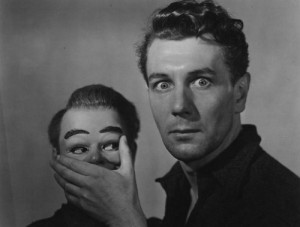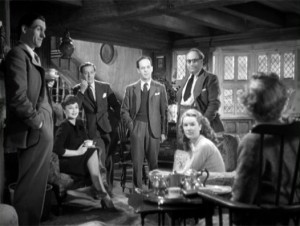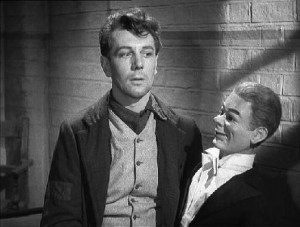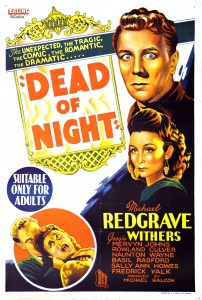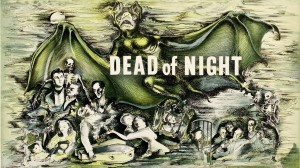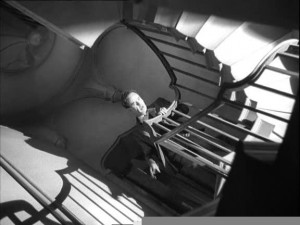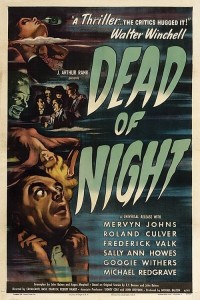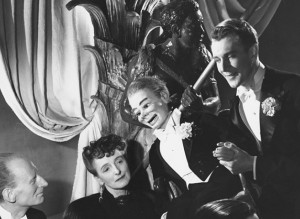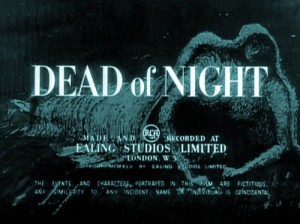Dead of Night ***** (1945, Mervyn Johns, Michael Redgrave, Roland Culver, Googie Withers, Sally Ann Howes) – Classic Movie Review 399
‘Suitable only for adults’, according to the poster, the famous vintage 1945 British chiller Dead of Night about a man’s fear of impending doom is satisfying, polished and still truly creepy. The hero’s half-remembered recurring dream turns into terrible reality as the guests at a country house tell him spooky supernatural tales.
The black and white British anthology horror film is made by Ealing Studios, and stars Mervyn Johns, Googie Withers, Sally Ann Howes, Roland Culver and Michael Redgrave, with segments directed by Alberto Cavalcanti, Charles Crichton, Basil Dearden and Robert Hamer. It is of a high quality throughout, but is best remembered for the concluding story with Redgrave as Maxwell Frere and an insane ventriloquist’s dummy.
Mervyn Johns stars as architect Walter Craig, who suffers from recurring nightmares. Seeking work, he visits a country farmhouse, where the other assembled guests encourage him to stay and take turns relating how their sinister and bizarre dreams are repeated for real.
A girl at a Christmas Party finds a hidden flight of stairs, goes up them and finds a boy who’s crying. An engaged couple marry and the wife buys the husband a mirror with a horrifying past. A man sees a hearse go by and a creepy man inside tells him ‘There’s room for one more’. Two golfers love a young woman so much that they challenge each other to a tournament. The winner gets to marry the girl and the loser drowns. A ventriloquist thinks his dummy is out to get him.
Ealing Studios’ deservedly renowned classic horror anthology of five ghostly stories is still genuinely eerie, particularly Michael Redgrave’s chilling turn as the ventriloquist Maxwell Frere, Googie Withers’s haunted mirror episode and the brilliant nightmare climax. It’s a shame that some of the performances have faded just a little, but otherwise it is still an untarnished classic deserving its high reputation among cinema buffs and horror fans. And Redgrave, Withers and Johns are perfect.
The five plus one stories are:
The Linking Story at Farmhouse (directed by Basil Dearden), with Anthony Baird as Hugh Grainger, Roland Culver as Eliot Foley, Renée Gadd as Mrs Craig, Sally Ann Howes as teenager Sally O’Hara, Mervyn Johns as Walter Craig, Judy Kelly as Joyce Grainger, Barbara Leake as Mrs O’Hara, Mary Merrall as Mrs Foley, Frederick Valk as Dr van Straaten and Googie Withers as Joan Cortland.
The Hearse Driver (directed by Basil Dearden; based on The Bus-Conductor by E F Benson, published in The Pall Mall Magazine in 1906), with Anthony Baird as Hugh Grainger, Judy Kelly as Joyce Grainger, Miles Malleson as the hearse driver/ bus conductor and Robert Wyndham as Dr Albury.
The Christmas Party (directed by Alberto Cavalcanti; story by Angus MacPhail), with Michael Allan as Jimmy Watson, Sally Ann Howes as Sally O’Hara and Barbara Leake as Mrs. O’Hara.
The Haunted Mirror (directed by Robert Hamer; story by John Baines), with Ralph Michael as Peter Cortland, Esmé Percy as antiques dealer Mr Rutherford and Googie Withers as Joan Cortland.
The Golfer’s Story (directed by Charles Crichton; based on The Story of the Inexperienced Ghost by H G Wells), with Peggy Bryan as Mary Lee, Basil Radford as George Parratt, Naunton Wayne as Larry Potter and Peter Jones as Fred the barman.
The Ventriloquist’s Dummy (directed by Alberto Cavalcanti, story by John Baines), with Allan Jeayes as Maurice Olcott, Magda Kun as Mitzi, Miles Malleson as the jailer, Garry Marsh as Harry Parker, Hartley Power as Sylvester Kee, Michael Redgrave as Maxwell Frere, Frederick Valk as Dr van Straaten and Elisabeth Welch as Beulah.
The writers are John Baines, Angus MacPhail and T E B Clarke, the cinematographer is Douglas Slocombe, the set designer is Michael Relph and the score is by George Auric. What a team! Ealing could boast some amazing talent back then.
Dead of Night opened at the Gaumont Haymarket cinema in London on 9 September 1945.
It runs 103 minutes.
Fascinatingly, horror films were banned from production in Britain during the Second World War, which makes Dead of Night a rare British chiller of the era, though it also has some of Ealing Studios’ trademark comedy in the hands of Basil Radford and Naunton Wayne as Parratt and Potter in The Golfer’s Story. The characters are similar to their Charters and Caldicott in Alfred Hitchcock’s The Lady Vanishes (1938).
It did well at the British box office in 1945 when the year’s biggest success was The Seventh Veil.
William Goldman’s screenplay for Richard Attenborough’s 1978 movie Magic had a very similar idea of the dummy taking over the ventriloquist (played by Anthony Hopkins). But that was the entire film!
© Derek Winnert 2013 Classic Movie Review 399
Check out more reviews on http://derekwinnert.com

